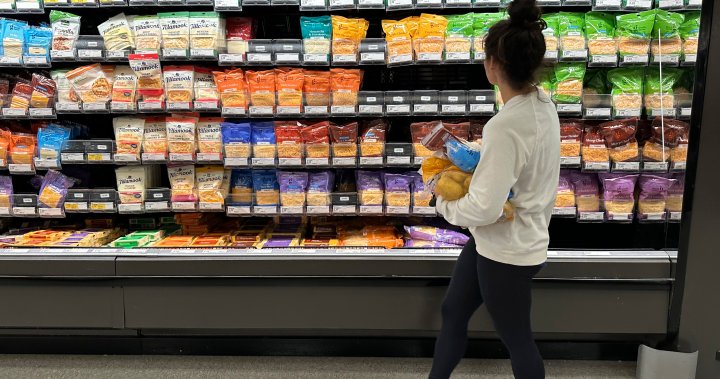
Canadians hoping for better food prices going into 2024 may not get their wish immediately, but as inflation cools, a new report suggests people could soon see some savings at the grocery store.
The 2024 Food Price Report released by Canadian researchers Thursday estimates food prices will increase by 2.5 to 4.5 per cent over the next year, which is down from the five to seven per cent forecast a year prior.
“That doesn’t mean that everything is going to be cheaper than it was before. It absolutely is not,” said Janet Music, one of the authors of the report, in an interview with Global News. “But it’s not going to be as expensive if things were going to keep going as they were.”
The report predicts food costs will go up across most categories, with the highest being among bakery, meat and vegetables — all showing an estimated five to seven per cent increase. However, the report expects dairy and fruits will see the lowest rise, at just one to two per cent. Restaurants are expected to see a modest increase of three to five per cent, while what the report calls “other” foods will rise about two to four.
According to the researchers, on average, a family of four can expect to spend up to $16,297.20, an increase of about $701.79 compared with what was spent in 2023. A two-adult household is expected to spend about $7,715.78, an increase of about $4 from the predicted amount the year prior.
The annual report is led by teams from Dalhousie University, the University of British Columbia, the University of Guelph and the University of Saskatchewan who use price data from the past 100 years to help create prediction models. Global events and other potential impacts are also factored in to form a detailed outlook for the months to come.
Music said whether the researchers’ forecasts play out will depend on how much Canadian families spend and whether they cut back on the types of foods they buy as was seen this past year, when they spent $693 less than the predicted $16,288.40.
While it may seem that the decrease could’ve meant savings in Canadians’ pockets, Music said the money may have gone elsewhere.

“The alarming thing about what we see in this report is that people, they weren’t buying as much food as they would have been this time two years ago,” Music said. “Where is that money going and why is this happening? It’s difficult to say, but … a very good kind of correlation is what we’re seeing in shelter costs.”
Next year’s expected increases come as food inflation sits at about 5.4 per cent, according to Statistics Canada figures released last month. September saw the rate at about 5.8 per cent which was a drop from 6.9 per cent in August.
Grocers under pressure to stabilize food prices
As Canadians faced the rising costs over the past year, grocers have been under pressure from the federal government to stabilize food prices, which has included a proposed grocer code of conduct.
A steering committee was established to oversee the development of the code in July 2021, but as it nears completion, several grocery chains have expressed concerns with Loblaw Companies Ltd., suggesting it could raise prices by more than $1 billion, according to a letter obtained by The Canadian Press.
Walmart Canada’s spokesperson Sarah Kennedy also said in an email to The Canadian Press in October that the company supports initiatives to benefit customers, but there could be “unnecessary burdens” that would be added to customers.
The code is near completion with plans to have it and the non-profit organization overseeing it up and running by the end of the first quarter of 2024.
However, Fraser Johnson, professor of operations management at Ivey Business School, said government agencies should not only look at grocers when it comes to trying to tackle food prices as other food retailers can impact the market, such as General Mills, Maple Leaf Foods and Proctor and Gamble.

“Ultimately what the retailers are doing is passing on their costs to the consumers,” Johnson said in an interview with Global News. “So not only do the retailers have to be responsible in terms of their pricing practices, but they also have to be aggressive with their suppliers to make sure that they’re getting competitive prices.”
Even though food inflation appears to be easing, the report notes various factors including the ongoing war in Ukraine, increased oil prices, and inflationary pressure due to escalating conflict in the Middle East could still cause higher prices in products like meat and bakery items.
It also noted climate change and energy costs — both of which have a very significant impact on prices — were very likely to shape the projected food costs next year. Issues like input costs or geopolitical risks, which can also have significant impacts, are likely to have an effect but it’s yet to be seen if it will be an increase or decrease, according to the researchers.
Johnson said with input costs decreasing it has meant a drop in grain prices, while the declining oil prices has resulted in a drop in transportation costs for food as well. He said these factors, as well as other drops in costs like packaging, will likely help ease some of the shocking prices seen earlier this year.
“I think the good news for the consumer is that we’ll continue to see a deceleration of food prices in 2024, probably in the range of around three per cent throughout the year,” Johnson said.

When it comes to these sorts of issues, Music says people can have an impact in various ways from calling on politicians to look for solutions to conflicts, or even tackling climate change through what people spend at the grocery story.
“I think people are making active choices to spend less money on food and that actually is a very good thing,” she said. “That will cut down on food waste, which does contribute to greenhouse gases and climate change as well.”
Looking at a coast-to-coast perspective, the report also notes while we could still see a widespread increase in food inflation, some provinces like Newfoundland and Labrador, Quebec and Prince Edward Island are forecast to see a drop — though they also have some of the highest percentage increases for food prices with both P.E.I. and Quebec sitting at 6.7 per cent.
But Johnson notes that while consumers going into their stores may not see a sudden drop in their milk or meat, at the same time they don’t have to worry about seeing the 10 per cent increases they saw in the winter or spring of 2023.
“I think, for individual shoppers, that will create opportunities to be able to look for substitutes, for looking at different retailers, for example, basically to be able to stabilize their food expenditures,” he said.
Music said people would still be smart to be diligent at watching receipts when buying groceries, plan meals ahead of time so you know what to buy, shop at different stores to find better prices and even use apps that have coupons available to use when shopping.
“Would I say that there’s going to be a collective sigh of relief on food prices, I think that may be a bit extreme,” she said. “But I think people can be cautiously optimistic in terms of some food prices.”
-with files from The Canadian Press, Global News’ Sean Boynton and Anne Gaviola
















